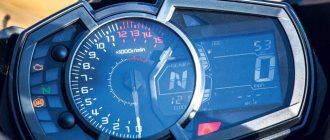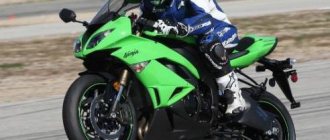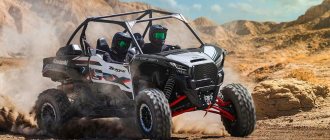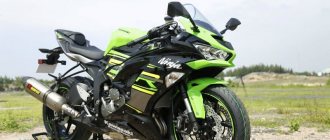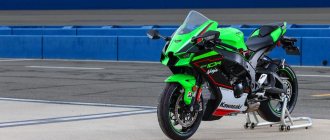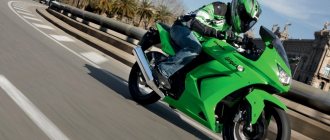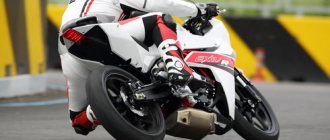This model replaced the legendary Kawasaki Ninja 250 P, but the latter never left the scene. Firstly, the new motorcycle from Kawasaki has a fuel-injected engine. The motorcycle also has a wider rear wheel, and it has lighter grip. However, overall the bike has not changed much compared to the 250 model.
The Kawasaki Ninja 300 is perfect for those who love relatively high speed: the bike can accelerate to 177 kilometers per hour, and it accelerates to 100 in 6.5 seconds. In addition, the motorcycle is not deprived of a bright design, which is generally similar to the design of the Ninja 250 R.
Dimensions and weight
The motorcycle is of average size for a sports bike. And compared to the average cruiser, it is absolutely tiny. The length of the bike reaches only 2015 millimeters. Its width is 715 millimeters. The height of the motorcycle itself reaches 1110 millimeters, while its height at the saddle is 785 millimeters. Wheelbase dimensions are 1405 millimeters.
The curb weight of the bike reaches 172 kilograms, but for versions with ABS it is 174 kilograms. This is a small weight and corresponds to the class of a motorcycle. Thanks to its relatively low weight, the bike is more maneuverable than many of its classmates of more impressive size.
Operating experience
Having analyzed popular reviews about the Kawasaki Ninja 300 online, we have compiled a list of features noted by bike owners:
- The dynamics allow you to drag from a traffic light with cars up to 300 - 350 hp. and win.
- Sensors of various systems are the weak point of the motorcycle; they will have to be serviced frequently.
- The controls are soft and the throttle is too sensitive.
- Errors when switching and opening the valve are forgiven by the slipper clutch.
- The mirrors on the Kawasaki Ninja 300 are set too close to each other.
Chassis and brakes
The frame of the bike has a diamond shape. It is made of steel, tubular. The steering wheel is small, as befits a sports motorcycle, and handling it on the road will be easy, unless, of course, this is the first time a person has ridden a bike. In general, sports options are generally not suitable for those who have never ridden motorcycles before.
The rear suspension is pendulum, similar to Uni-Trak. Its stroke is 132 millimeters. The front suspension is represented by a 37 mm telescopic fork with a stroke of 120 mm.
For the rear brakes, the motorcycle has a disc with a diameter of 220 millimeters and a two-piston caliper. At the front, the brakes are represented by a single disc with a diameter of 290 millimeters and a two-piston caliper.
Kawasaki Ninja 300 technical specifications
The engine is a 4-stroke, in-line, 2-cylinder unit with water cooling. The volume is 297 cubes, allowing you to squeeze 37 hp out of it. on the wheel and 24 meters of torque. Such good performance was achieved through the use of an injection system with dual throttle valves. The latter allow the engine to remain elastic throughout the entire speed range. The heart of the bike is enclosed in a steel diamond-shaped tube frame, giving impressive rigidity to the entire structure, while the motorcycle weighs only 172 kg.
Dynamics – stated acceleration to 100 within 6 seconds. Decent performance for the class and excellent for driving in the city. With such dynamics, leaving most of the traffic at the traffic lights will not be difficult. At the same time, the Kawasaki Ninja 300 has a maximum speed of approximately 180 km/h. The indicators are average, but there is something to be surprised about. The motor has an impressive torque, comparable to larger engines. At a speed of 100 km/h and in 6th gear, the motorcycle accelerates quite easily when the gas is opened. That is, you can move along the highway or in traffic without constantly switching and spinning the engine up to 10 - 12 thousand revolutions to speed up.
The transmission is a standard 6-speed, with the function of switching to neutral when coming to a complete stop. Drive – chain.
The suspension is represented by a 37 mm telescopic fork at the front, and a swingarm with a single Uni-Trak shock absorber at the rear.
It all stops thanks to a 290 mm disc at the front and a 220 mm disc at the rear, through the force of two-piston calipers. For an additional fee, you can install the latest generation ABS system from Nissin on the Kawasaki Ninja 300.
When considering the technical specifications of the Kawasaki Ninja 300, it is worth mentioning the slipper clutch system. This system comes straight from motorsports and allows you to maintain rear wheel traction when downshifting.
Advantages
Considering the Kawasaki Ninja 300 technical characteristics and other features of the model, the following advantages can be highlighted:
- A powerful and flexible motor is reliable, unpretentious, which means we can talk about low operating costs.
- From a distance and up close, the motorcycle does not look stripped down or flawed, thanks to its similarities with its older brothers.
- Even a tall rider can sit comfortably on the bike.
- With careful driving, consumption can be a measly 3.5 liters.
- Excellent handling, together with safety systems, make it safe for novice motorcyclists.
- Possibility to add ABS function to Kawasaki Ninja 300.
- The air exhaust system from the radiator is designed in such a way that the heated air does not reach the rider - a useful feature, especially in summer toffees.
- There is a large selection of custom and factory tuning that allows you to turn a standard model into a Kawasaki Ninja 300 as in the photo.
What didn't you like about the Kawasaki Ninja 300?
- When traveling long distances, you have to twist into a shrimp position so that the oncoming air flow does not rip you off the saddle.
- The exhaust sound is very buzzing, reminiscent of a lawn mower - not at all consistent with the fast appearance of the motorcycle and its capabilities.
- The engine is demanding on the quality of fuel and lubricants, so refueling at dubious pumps or skimping on oil can soon lead to unpleasant and expensive engine repairs.
Competitors
The Yamaha YZF-R3 is practically the twin brother of the Kawasaki Ninja 300, this is clearly visible in the photo. The motorcycles are very similar ideologically, but the Yamaha has a slightly larger engine, which means better acceleration by a fraction of a second and a 10 km/h better top speed.
Honda CBR 300 is another budget sportbike. The smaller volume makes the Honda slightly slower on a straight line, but excellent torque and low weight allow it to show good dynamics.
Comparing the Kawasaki Ninja 300 technical specifications with the presented competitors, we will find that the motorcycles are very similar and it will be possible to find a winner only in a head-to-head bet.
Who is it suitable for?
For a beginner - 100%. Leave the boring 125s and 200s to the kids. If you want to start your first season with something normal, buy a Kawasaki Ninja 300. First of all, because once you start riding normal equipment, you will get the whole gamut of positive emotions that a motorcycle can give. This is not a product of the Chinese market, but a space shuttle on the road.
In addition, the Kawasaki Ninja 300 has excellent maximum speed and dynamics, so you won’t be trailing behind the flow, turning the gas to full, but leading it.
For an experienced biker - yes. If you read some of the reviews about the Kawasaki Ninja 300, it will become clear why motorcyclists with many years of experience buy it – it’s a pleasure. Moving around the city on such a motorcycle, even an elderly motorcyclist will receive pure joy from the good response to the throttle, the amazing agility of the motorcycle and the ridiculous consumption, in comparison with motorcycles with a capacity of 600 cc.
REVIEW – KAWASAKI Brute Force 300
KAWASAKI Brute Force 300 is the most popular ATV in the series. And in 2013, it was named ATV of the Year by ATV Illustrated magazine. There are several reasons for this success: firstly, it is an excellent symbiosis of consumer qualities. Excellent handling, high-torque engine, wide list of accessories. Secondly, this is an acceptable price compared to competitors. An intriguing application from KAWASAKI for the title of an excellent au pair! We couldn’t pass by without taking a closer look at the new 2022 product.
Features of the KAWASAKI Brute Force 300 chassis
Structurally, the ATV is a proven design with a 271 cc single-cylinder engine. cm and rear-wheel drive. Torque is transmitted to the drive wheels through a variator, which makes riding the quad intuitive. In addition to smoothing out transmission jerks, the CVT can simulate engine braking, which is useful when descending long slopes. It's nice that the KAWASAKI Brute Force 300 transmission is equipped with a reduction gear, even though it is rear-wheel drive. This was done primarily not for overcoming off-road conditions, but for towing trailers. The cargo capabilities of this ATV are very impressive, so it makes sense to talk about them separately.
In the photo: general view of the KAWASAKI Brute Force 300
Otherwise, the transmission is the same as the “big ones”: there is a reverse gear and an overdrive range.
The torque plateau is shifted to the low and medium speed zone to compensate for low power and increase engine life. The engine is liquid cooled, like its “big brother” - KAWASAKI Brute Force 750i. The chassis looks borrowed from more expensive and powerful models: the front suspension is on double wishbones with five-way spring preload adjustment, the rear suspension is similarly adjustable, connected through the rear swingarm. This balanced design makes the KAWASAKI Brute Force 300 a class leader in ride and handling.
In the photo: the design of the rear part of the ATV - brake disc, axle and monoshock absorber with adjustable spring preload
Continuity in everything
Externally, the ATV is a current development of the KAWASAKI corporate style. The design of its predecessor is perfectly balanced and evokes positive emotions. By the way, the 2022 model year ATVs are available in white and black.
In the photo: general view of the KAWASAKI Brute Force 300 in white
Without a doubt, the design of the younger model was created with an eye to its predecessors: the same aggressive shapes of bumpers made of durable unpainted plastic, the characteristic contours of the lighting equipment. The features of a purely utilitarian vehicle are striking: massive fenders that will protect the rider from dirt flying out from under the wheels, a well-thought-out cargo securing system.
In the photo: the fast-moving KAWASAKI Brute Force 300
Recipe for a “quad train” from KAWASAKI Brute Force 300
It is worth taking a closer look at the totality of all the traction qualities of this ATV, since it is classified as utilitarian. You can attach any luggage to the above-mentioned grates: tools, hunting accessories, a supply of fuel in a canister, or even baskets of mushrooms and berries. The front platform is designed for 20 kg of cargo, and the rear - for 30 kg: this is due to the fact that the front part of the ATV is already loaded with the mass of the engine.
Under the front platform there is a spacious compartment for tools that you may need on the road: for example, a pressure gauge and a multitool.
In the photo: the front cargo platform of an ATV with an additional compartment
It is important to remember that the ATV is designed with a large margin of safety: for this reason, it is tempting to exceed the permissible payload. According to the passport, the total weight of the rider and cargo should not exceed 164 kg, which is more than enough for everyday use.
In the photo: rear platform with a load capacity of 30 kg
Manufacturers often place containers for storing small items under the seat, but not in our case. KAWASAKI engineers took care of the reliability of the quad by placing the air filter housing and fuse box under the saddle. This arrangement will protect the vital components and assemblies of the ATV from water and dirt. Another small container is located in the right front fender; its volume is enough for a small set of tools.
In the photo: general view of the driver’s workplace
Continuing to expand on the topic of utilitarianism, let’s take a closer look at the stern of the “three hundred”. What catches your eye is the towbar, which you don’t always see on older models. The traction capabilities of the engine allow you to tow a trailer with a total weight of up to 227 kg. Thus, the weight of a fully loaded “quad train” exceeds 600 kg, which makes us take the youngest ATV in the family even more seriously.
In the photo: socket for attaching the towbar ball
With an eye on the elders: KAWASAKI Brute Force 300 braking system
After mentioning such heavy loads, it’s worth talking about the KAWASAKI Brute Force 300 braking system. There are two brake discs with a diameter of 180 mm each on the front axle, and one disc of the same size on the rear axle. The lever on the left handle is responsible for activating the rear brakes, and the right lever is responsible for activating the front brakes. The pedal under the rider's right foot is responsible for braking the rear wheels.
On each side of the steering wheel you will see a brake fluid gauge. And there are two of them because the braking system consists of two independent reservoirs and two working brake cylinders. In other words, even if you damage the front or rear brake line on the road, you will still be able to use the undamaged mechanism in any case. We have already mentioned the ability of the variator to simulate engine braking, which will also help in a difficult situation.
In the photo: front brake disc with a diameter of 180 mm with a single-piston caliper
Exclusive from Maxxis
The Brute Force 300 wheels also stand out from the competition - they have an “adult” diameter of 22 inches, and the tires were designed by Maxxis specifically for KAWASAKI. A tread pattern with a developed lug system allows you to achieve a balance between handling and cross-country ability, and the high profile of the tires will smooth out uneven road surfaces.
In the photo: universal Maxxis tires and ground clearance of 154 mm
Dark horse of the Brute Force family
The KAWASAKI Brute Force 300 has drive only on the rear axle, which changes preferences from “directions” to roads with some kind of hard surface. But if you need to overcome a section with severe off-road conditions, the “three hundred” has every chance of not giving up in front of an obstacle.
You can improve cross-country ability by the most obvious method - reducing the pressure in the tires, since they can easily withstand such exercises. The minimum pressure in the front wheels is 0.32 atm, and in the rear wheels - 0.25 atm. To restore working pressure, you don’t have to use a foot pump: the quad is equipped with a 12 V socket, so you can connect any additional equipment from a compressor to a GPS navigator.
In the photo: the basic placement of a 12 V socket on the KAWASAKI Brute Force 300 and KAWASAKI Brute Force 750 ATVs
By the way, the design of the ATV includes the ability to install a winch in the front bumper. Its carrying capacity of 400 kg is more than enough to rescue the quad from difficult situations. It’s gratifying that you can order the installation of a winch from an official representative: this means that you still have a warranty on the equipment.
In the photo: one of the options for installing a winch on an ATV
To sum up the off-road capabilities of the KAWASAKI Brute Force 300, it is worth mentioning the recoil starter system. Anything can happen on the road, including battery discharge. A redundant engine starting system will help you get to the repair site, which will eliminate the “rescue operations” that take so much time and money.
In the photo: the manual starter is located on the left side of the ATV
All the best for children
In addition to the utilitarian, there is one more possible use for the KAWASAKI Brute Force 300: due to its simple controls and low weight of 243 kg, this quad is perfect for a teenager. Simple and intuitive controls and predictable engine character will make mastering the basics of riding fun and safe. To limit the power, a special adjustment mechanism is provided, which will protect the inexperienced rider. With increasing experience, you can gradually add speed to the engine in order to proportionally improve the driver's skills.
In the photo: KAWASAKI Brute Force 300 in its native elements
Summing up
As a result, we have an entry-level ATV that has an advanced design that is unusual for its competitors. And even if this is not the ultimate solution to any one problem, the main feature of the KAWASAKI Brute Force 300 lies precisely in the variety of applications. It will perfectly cope with various household tasks - transporting equipment and building materials - due to a well-thought-out system for securing luggage and the presence of a tow bar.
Pictured: KAWASAKI Brute Force 300 utility in action
In a difficult situation, it will take you home thanks to a large number of redundant systems: a manual starter and a reliable braking system. As already mentioned, you can trust the control of the ATV to a teenager without fear thanks to intuitive controls and the ability to limit the power output. Even despite the rear drive axle, the KAWASAKI Brute Force 300, due to its low weight, high-quality universal tires and reduction gear, can easily get through the thick jungle. And the built-in winch will completely equalize the chances of the “three hundred” in comparison with its all-wheel drive counterparts, because on serious off-road conditions everyone without exception “winches.”
Pictured: KAWASAKI Brute Force 300 off-road
KAWASAKI Brute Force 300 sets a new level of technical equipment for the entire class: it has a liquid-cooled engine and a full-fledged CVT transmission with a reduction range. And the bottom line is a multi-purpose ATV with excellent handling and a reliable assistant on the farm.
Pictured: KAWASAKI Brute Force 300 white
Features of KAWASAKI Brute Force 300
- 271 cc engine cm, tuned for maximum torque in the low and medium speed zone
- the variator design is borrowed from the flagship of the model range, KAWASAKI Brute Force 750 4x4i EPS
- The presence of a manual starter increases the chances of starting the engine in difficult situations
- The air filter is located high above the ground, under the driver's seat
- master cylinder maintaining excellent braking balance between front and rear axles
- When developing the “300”, the experience of creating larger ATVs of the Brute Force family was widely used
- Light and durable frame can easily withstand heavy loads both when transporting loads and when driving fast
- excellent cornering stability due to the wide track width of the ATV (830 mm front, 812 mm rear)
- Improved mud protection thanks to redesigned rider footplates
- additional extension of the front fenders to protect against dirt
- 12 liter fuel tank and 2.3 liter reserve
- Contrasting digital display with backlight is readable in any weather and at any time of the day
- composition of displayed instruments: speedometer, odometer, fuel gauge, engine temperature gauge, transmission mode indicator (LHNR)
- convenient location of the 12 V socket to the left of the steering wheel allows you to attach a variety of additional equipment
- comfortable seat with soft upholstery makes long hauls accessible
- A versatile tire that combines excellent grip and durability, designed by Maxxis specifically for KAWASAKI
- detailed fit of all elements guarantees the highest quality of assembly
- KAWASAKI branded accessories are available for this model: windshields, panniers, expedition bags, etc.
Characteristics of KAWASAKI Brute Force 300
Engine type : liquid cooled, 4-stroke single cylinder
Engine capacity : 271 cm³
Bore × Stroke : 72.7 × 65.2 mm
Compression: 11.0:1
Power : 16 kW (22 hp) / 7,500 rpm
Torque : 22.3 Nm / 6,500 rpm
Fuel injection system : SOHC, 2 valves, Keihin CVK32 carburetor
Transmission : CVT, 2 speeds with reverse gear
Final drive : rear-wheel drive, propeller shaft
Frame : perimeter made of high-strength steel
Front suspension : Double wishbones with 5-step spring preload adjustment
Rear suspension : Swingarm with 5-step spring preload adjustment
Front tire : AT 22 x 7-10 Maxxis
Rear tire : AT 22 x 10-10 Maxxis
Front suspension travel : 127 mm
Rear suspension travel : 127 mm
Front brake : two 180 mm discs. Single piston calipers
Rear brake : single 180mm disc. Single piston caliper
Weight : 242 kg
Wheelbase : 1,165 mm
Fuel tank capacity : 12 l

